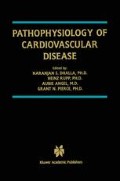Summary
The present study is designed to investigate the mechanism of cardioprotective effect of remote aortic preconditioning. Four episodes, each episode comprising of 5min aortic occlusion followed by reperfusion for 5min were employed to produce remote preconditioning. Heart was isolated, perfused on Langendorff’s apparatus and subjected to 30 min of sustained global ischaemia followed by reperfusion for 120min. Coronary effluent was analysed for LDH and CK release to assess the degree of cardiac injury. Myocardial infarct size was estimated macroscopically using TTC staining. Remote aortic preconditioning reduced release of LDH and CK in coronary effluent and decreased myocardial infarct size. Reserpine, a biogenic amine depletor, ruthenium red, a sarcoplasmic reticulum Ca2+ channel blocker, ethylisopropylamiloride, (EIPA) a Na+/H+ exchange inhibitor and gadolinium, a mechanosensitive channel blocker, did not modulate the cardioprotective effect of remote aortic preconditioning. On the other hand, verapamil, a L type Ca2+ channel blocker, and 2′,4′-dichlorobenzamil, a Na+/Ca2+ exchange inhibitor, attenuated the cardioprotective effect of remote aortic preconditioning. On the basis of these results, it may be suggested that the cardioprotective effect of remote aortic preconditioning may be mediated through opening of L-type Ca2+ channels or activation of Na+/ Ca2+ exchange.
Access this chapter
Tax calculation will be finalised at checkout
Purchases are for personal use only
Preview
Unable to display preview. Download preview PDF.
References
Murry CE, Jennings RB, Reimer KA. 1986. Preconditioning with ischaemia: a delay of lethal cell injury in ischaemic myocardium. Circulation 74:1124–1136.
Przyklenk K, Bauer B, Ovize M, Kloner RA, Whittaker P. 1993. Regional ischaemic “preconditioning” protects remote virgin myocardium from subsequent sustained coronary occlusion. Circulation 87:893–899.
Gho BCG, Eskildsen-helmond YEG, de Zeeuw S, Lamers JMJ, Berdouw BD. 1976. Does protein kinase C plays a pivotal role in the mechanism of ischaemic preconditioning. Cardiovasc Drugs Ther 10:775–786.
Takaoka K, Yabe T, Morikawa S, Inubushi T, Kinoshita M. 1999. Renal ischaemia/reperfusion remotely improves myocardial energy metabolism during myocardial ischaemia via adenosine receptors in rabbits: effects of “remote preconditioning”. J Am Coll Cardiol 33:556–564.
Schoemaker RG, van Heijningen CL. 2000. Bradykinin mediates cardiac preconditioning at a distance. Am J Physiol 278:H1571–H1576.
Kaur K. 1998. Acute and delyed cardioprotective effects of remote renal preconditioning in rat. M. Pharm Thesis, Punjabi University, Patiala.
King J. 1959. A routine method for the estimation of lactic dehydrogenase activity. J Med Lab Tech 16:265–272.
Hughes BP. 1961. A method for the estimation of serum creatine kinase and aldose activity in the normal and pathological sera. Clin Chim Acta 7:597–603.
Fishbein MC, Meerbaum S, Rit J, Lando U, Kanmatsuse K, Merair JC, Corday E, Ganz W. 1981. Early phase acute myocardial infarct size quantification: validation of the triphenyltetrazolium chloride tissue enzyme staining technique. Am Heart J 101:593–600.
Klein HH, Puschmann S, Schaper J, Schaper W. 1981. The mechanism of the tetrazolium reaction in identifying experimental myocardial infarction. Virchows Arch 393:287–297.
Chopra K, Singh M, Kaul N, Andrabi KI, Ganguly NK. 1992. Decrease of myocardial size with desferoxamine. Possible role of oxygen free radicals in its ameliorative effects. Mol Cell Biochem 113:71–76.
Parikh V, Singh M. 1999. Possible role of adrenergic component and cardiac mast cell degranulation in preconditioning-induced cardioprotection. Pharmacol Res 40:129–131.
Sharma A, Singh M. 2001. Protein kinase C activation and cardioprotective effect of preconditioning with oxidative stress in isolated rat heart. Mol Cell Biochem 219:1–6.
Sharma A, Singh M. 1997. The possible role of adrenergic component in ischaemic preconditioning. Meth Find Exp Clin Pharmacol 19:493–499.
Sharma A, Singh M. 2000. Possible mechanism of cardioprotective effect of ischaemic preconditioning in isolated rat heart. Pharmacol Res 41:635–640.
Sharma A, Singh M. 2000. Possible mechanism of cardioprotective effect of angiotensin preconditioning in isolated rat heart. Eur J Pharmacol 406:85–92.
Miyawaki H, Ashraf M. 1997. Calcium as a mediator of ischaemic preconditioning. Circ Res 80: 790–799.
Gannier F, White E, Gamier D, Le Guennec JY. 1996. A possible mechanism for large stretch-induced increase in intracellular calcium in isolated guinea-pig ventricular myocytes. Cardiovasc Res 32: 158–167.
Tanaka Y, Hata S, Ishiro H, Ishii K, Nakayama K. 1994. Stretch release calcium from intracellular storage site in canine cerebral arteries. Can J Physiol 72:19–24.
Morris CE. 1990. Mechanosensitive ion channels. J Membr Biol 113:93–107.
Bustamante JO, Ruknudin A, Sachs F. 1991. Stretch-activated channels in heart cells relevance to cardie hypertrophy J. Cardiovasc Pharmacol 17:S110–S113.
Ohara F, Sugimoto T, Yamamoto N, Okhubo K, Maeda K, Ozaki T, Seki J Gato T. 1999. Preischaemic and postischaemic treatment with a new Na+/H+ exchange inhibitor, FR 183998, shows cardioprotective effects in rat with cardiac ischaemia and reperfusion. J Cardiovasc Pharmacol 34:848–856.
Yamamoto S, Matsui K, Kitano M, Ohashi N. 2000. SM-20550, a new Na+/H+ exchange inhibitor and its cardioprotective effect in ischaemic/reperfused isolated rat hearts by preventing Ca2+-overload. J Cardiovasc Pharmacol 35:855–862.
Meng HP, Maddaford TG, Pierce GN. 1993. Effect of amiloride and selected analogues on post ischaemic recovery of cardie contractile function. Am J Physiol 264:H1831–H1835.
Bugge E, Munch-Ellingsen J, Ytrehus K. 1996. Reduced infarct size in the rabbit heart in vivo by ethyhsopropyl-amiloride. A role for Na+/H+ exchange. Basic Res Cardiol 91:203–209.
Tani M, Neely JR. 1989. Role of intracellular Na+ in Ca2+ overload and depressed recovery of ventricular function of reperfused ischaemic rat hearts: possible involvement of Na+/H+ and Na+/Ca2+ exchange. Circ Res 65:1045–1056.
Deshpande SB, Fukuda A, Nishino H. 1997. 3-Nitropropionic acid increases intracellular calcium in cultured astrocytes by reverse operation of Na+/Ca2+ exchanger. Exp Neurol 145:38–45.
Author information
Authors and Affiliations
Corresponding author
Editor information
Editors and Affiliations
Rights and permissions
Copyright information
© 2004 Springer Science+Business Media Dordrecht
About this chapter
Cite this chapter
Singh, M., Sharma, A. (2004). Mechanism of Cardioprotective Effect of Remote Aortic Preconditioning. In: Dhalla, N.S., Rupp, H., Angel, A., Pierce, G.N. (eds) Pathophysiology of Cardiovascular Disease. Progress in Experimental Cardiology, vol 10. Springer, Boston, MA. https://doi.org/10.1007/978-1-4615-0453-5_21
Download citation
DOI: https://doi.org/10.1007/978-1-4615-0453-5_21
Publisher Name: Springer, Boston, MA
Print ISBN: 978-1-4613-5084-2
Online ISBN: 978-1-4615-0453-5
eBook Packages: Springer Book Archive

